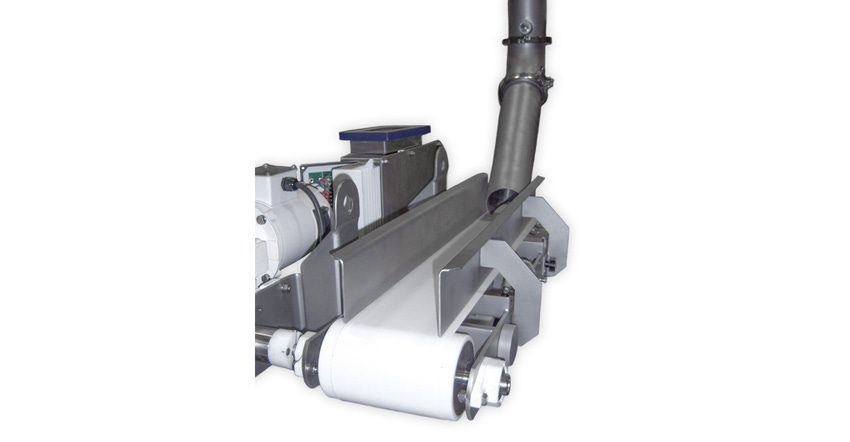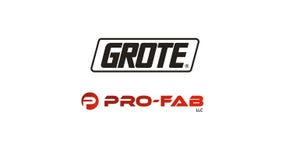Proper selection and optimization of a belt feeder can be difficult but is necessary for ensuring best results.
May 30, 2023

Ed Boardway, senior VP of research & development, Merrick Industries Inc.
Weigh belt feeders are intended to accurately meter or feed dry bulk materials into processes. As processes become more complex, recipes more varied, and ingredients more difficult to handle, the need to correctly align the belt feeder to the process and its requirements is ever more critical. The primary purpose of the belt feeder is to accurately weigh the material being fed, but there are many factors that influence or even define the success or failure of a belt feeder in any application. This article will serve as a guide through some of the major pitfalls that can occur.
Belt Feeders Are Not Pumps
The first principle of belt feeders is that they are not pumps. They do not “pull” material from the hopper or bin that is upstream of the belt feeder, and they do not “push” it into the process that is downstream. Generally, the process of getting material to the belt feeder is outside of the scope of the feeder supplier’s responsibilities, but this is critical and can be a very difficult part of the system design. For the belt feeder to feed and weigh the material accurately and consistently, the flow of material to the belt feeder must also be consistent. And, if the material being fed is a mixture of ingredients, the flow to the feeder must also be maintained without segregation, or alteration of the blend. Otherwise, the individual ingredients may dominate the feed at different time intervals and distort the final product.
The science of getting a specific material to flow through the upstream process reliably to the belt feeder can be very complicated and is not the subject of this article. Typically, the goal upstream of the belt feeder is “mass flow” out of the hopper or bin, which will ensure “first in – first out” flow without segregation or ratholing. Often a great deal of effort is involved to ensure reliable flow to the belt feeder, and it is therefore incumbent on it to help maintain this flow out of the hopper or bin.
Proper Feeder Design Starts with the Infeed
The belt feeder infeed is the interface between the upstream process and the feeder belt itself, and therefore the proper design of the feeder must start here. The infeed must be designed to accomplish or support the following:
* Consistent flow from the upstream process. At minimum this means sizing the inlet properly to match the bin outlet, which may be round, square, rectangular, obround, etc., but it may also include a special design to support mass flow out of the bin or hopper.
* Conditioning the material so that it provides a consistent loading on the belt. Often the material is sheared out of the infeed, which means it is continually fractured as it is forced from vertical flow (i.e., by gravity) to horizontal. The force required to shear the material depends on the flow properties of the materials and is produced by torque applied at the drive pulley. Sometimes the material cannot be sheared (e.g., sliced, fibrous, or shredded material), or shearing isn’t desired due to degradation of the material (e.g., cereal flakes). In these cases, a special infeed can often be developed to reduce or eliminate the shearing action. In all cases, the goal is to get the material onto the Feeder belt, in a uniform and consistent manner, and moving with the belt.
Figure 1 illustrates a small belt feeder with a very special infeed designed for sliced almonds. The almonds could not be sheared and would not feed out of a hopper with any kind of convergence. The entire material handling system upstream of the belt feeder and the infeed was designed as a system to allow the almonds to flow onto the belt easily and with no shearing. The design of the infeed was integral to the ultimate success of this project.
For proper design of the infeed, you must know the configuration of the upstream process (e.g., bin design) and have a good understanding of the properties of the material to be fed. Most materials can be fed with a belt feeder, but all require at least some consideration, and some may require special consideration, depending on their specific properties.
Bulk Density is Critical
One of the critical properties of the material to be fed is, of course, bulk density. A material’s bulk density comprises the basic relationship between the size of the belt feeder and gravimetric capacity. It is also the parameter most often mis-stated. The bulk density of a material can be difficult to ascertain, as it can vary quite a bit for any given material, depending on the conditions under which it is being measured, and the material’s specific properties (e.g., particle size). Often, a material’s specific gravity is mistaken for bulk density, when in fact the two parameters have little to do with each other. For example, hydrated lime has a specific gravity of about 2.2 (137 lb/ cu ft). Yet its bulk density may be as low as 25 lb/cu ft. If there is any doubt about a material’s bulk density (and there is probably always some doubt), or if the material is new, then a test of the bulk density, under precise conditions, should be done. If testing is performed correctly, it can reveal a lot about the material’s compressibility, cohesiveness, and general flow properties in addition to an accurate assessment of the bulk density. These parameters will help inform the proper design of the belt feeder.
Having determined the belt feeder infeed and the interface to the upstream process, the basic feeder design can proceed. The profile of the material on the belt is known, the bulk density is known (see above), and so the belt loading can be calculated (or at least estimated fairly accurately). Also, the required belt width can be determined, and this usually determines several basic dimensions of the belt feeder. From the estimated belt load, and the required capacity (given), the required belt speed can be determined. Often the design process is iterative and can sometimes be difficult to optimize. An example is when the material or the upstream process (e.g., size of the bin opening) indicates a large belt feeder, but the required capacity is low. Because the belt load is higher (due to the size of the infeed and the large cross-section of material on the belt), and the capacity is low, the required belt speed will likely be very slow. This isn’t necessarily a problem but can exacerbate a discharge phenomenon known as “avalanching.” This is when the material falls off the head pulley (or discharge terminal) in discrete chunks rather than as a continuous stream. This is similar to the “surging” effect that is often observed at the discharge of a screw, produced by the rotation of the screw, and is not uncommon. Figure 2 illustrates graphically the avalanching effect on a real Belt feeder.

The Y-axis represents accumulated weight, collected in a container on a scale as it falls off the head pulley of the belt feeder. The X-axis represents elapsed time. The data has been collected at a very high sample rate and slightly averaged to “smooth” the data somewhat. The avalanching effect can be readily observed as a stairstep-like accumulation of weight versus time. The flat sections of the graph are periods of time when no material is being discharged, i.e., right after a chunk of material has fallen off the head pulley.
On a belt feeder this avalanching effect happens more often than not, but is usually not a problem, as long as the downstream process can tolerate the short-term variations in flow. Most processes have at least a small amount of residence or detention time, which serves to adequately average or smooth out the feed rate. However, some processes--like high-speed filling applications--depend on second-to-second feed rate consistency. Avalanching is exacerbated by very low belt speed and a material’s flow properties (e.g., cohesiveness), which must be considered in these applications. There are things that can be done to mitigate avalanching if it is known or expected. The belt feeder shown in Figure 1 (for sliced almonds) required a very low capacity (i.e., a few kg/hr), and therefore a very low belt speed. To mitigate the avalanching, a vibratory feeder was added at the discharge of the belt feeder, to accumulate and then disperse the chunks of almonds that fell (avalanched) off the head pulley of the belt feeder. The controls were integrated into the belt feeder controls, and the resultant feed rate into the process was very consistent and accurate. Testing by the feeder supplier can generally reveal the likelihood and the downstream effects of avalanching, and various solutions can be discussed.
Belt Feeders Do Not Have Infinite Turndown
It is also worth noting a second principle of belt feeders, which is they do not have infinite turndown (the ratio between max capacity and min capacity). While belt feeders can be designed for a huge range of capacities (e.g., from a few kg/h to hundreds of t/h), any individual belt feeder can only have a much more limited range. A belt feeder depends primarily on variable speed control to control feed rate, and if the belt feeder has been optimized for the material and the application, generally speed will need to be varied only over a narrow range.
One more factor concerning the proper selection of a belt feeder is the environment it must operate in, specifically the hazardous area classification (i.e., ATEX or NFPA). It is incumbent on the owner of any dust or powder processing facility to have performed a dust hazardous analysis (DHA) per NFPA. This will reveal any hazards associated with the material to be processed and help inform the feeder supplier of any particular requirements to satisfy the safety aspects of the application.
Summary
In summary, proper selection and optimization of a belt feeder for a specific material in a specific process can be difficult but is necessary for ensuring best results. Most belt feeders will weigh accurately, but for maximum performance of the belt feeder within a process, a comprehensive understanding of the material characteristics, the upstream process, and the downstream process is essential. A “standard” belt feeder is not always the best solution, nor can one feeder “fit” all applications. All the above factors should be discussed with your feeder supplier. Look to select a feeder supplier with broad experience, expertise, and willingness to perform testing if required.
Ed Boardway is the senior VP of research & development at Merrick Industries Inc. (Lynn Haven, FL) and has more than 40 years of experience helping customers find solutions to difficult material feeding problems. For more information, call 850-265-3611 or visit merrick-inc.com.
You May Also Like


